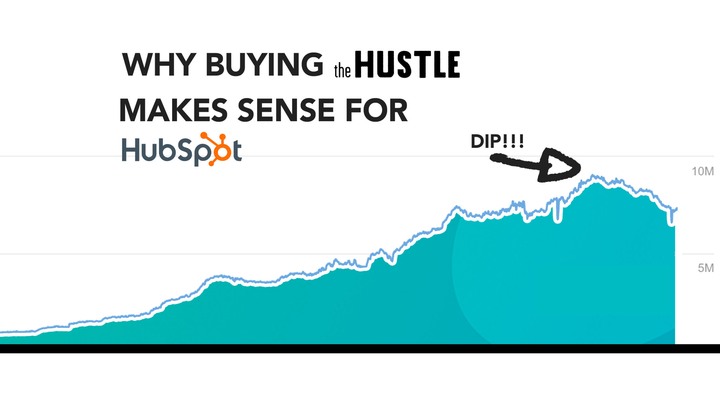There are a ton of rumours floating around that Hubspot spent $25-$30M on the Hustle.
Let’s say that’s true.
It’s not a small chunk of change, but for comparison’s sake:
That’s the cost of six 30-second Super Bowl ads.
Do I have your attention? Good.
The Hustle is estimated to have:
- Between 5-8M annual visitors to their main site
- Over 500k-2M annual visits to Trends (paid site) per year
- Over 11k members in various niche FB groups
- And over 1.5M newsletter subscribers
And now Hubspot has access to all of it. If you go back in time, there’s no question that Hubspot has always been a leader in understanding the importance of embracing content.
It’s estimated that their site generates 360M annual visits [via SimilarWeb].
That’s a combination of direct, organic, social, and referral traffic.
Hubspot’s content has become a staple in the world of marketing as an example of best practices for blogging, SEO, and marketing as a whole. But recently, there seems to be a slight dip in organic traffic.

While the only way to truly know if the SEO tools are right is to log into Hubspot’s Analytics dashboard, the sources we have in our repertoire roughly indicate a drop of anywhere from 500k-1M monthly visits. That’s a lot of lost value for a brand that was showing an organic growth trajectory that resembled a dream stock pick.
The value associated with Hubspot’s organic traffic (volume x average PPC cost) is a little under $25M. In other words, you would have to spend nearly $25M per month to generate as much traffic as Hubspot does. This value demonstrates the power of creating content that ultimately arms you with the ability to build an SEO moat.
The brand has essentially operated as a media entity in the marketing world for years. They coined the idea of “inbound marketing” and have lived and breathed their own definition by creating an inbound engine that consistently drove results. These efforts included:
> Hubspot’s Content Engine: It’s estimated that the Hubspot blog alone generates 5M visits a month.
> Hubspot’s “Templates”: These templates generate more than 140,000 annual visits from people looking for “proposal templates” and “schedule templates.”
> Hubspot’s Alternative Pages: On any given day, hundreds of people are looking for Salesforce and Calendly alternatives. Hubspot captures some of this traffic through “alternative pages” that, combined, generate more than 20k visits a month.
> Hubspot’s Website Grader: In 2017, this tool generated 524k uniques, 51k leads, 1.5K influenced opps, 122 influenced wins, and $8.5M in lifetime value.
Why do I bring all of this up?
Because it’s important to know that Hubspot has been “all in” on content for years.
The team has even dabbled in community building with experiments like Inbound.org (no longer around) and offering industry courses (which are just content) to help elevate the industry at large.
So, where does The Hustle come into the mix?

As mentioned, it looks like Hubspot’s content engine may have experienced a slight dip in traffic over the last few months. There are a number of possible reasons for this dip—and the dip may not even be a reality (there are sometimes discrepancies between analytics and SEO tools). But, if it is true…
Then making a move on The Hustle makes sense.
The Hustle was generating between 5-8M visits per year. That alone covers the dip in site traffic that Hubspot *may* have recently seen. Combine that with the fact that The Hustle has an “owned audience” in it’s newsletter and Facebook group and the acquisition drips with a whole bunch of marketing brilliance.
But what’s most interesting (and likely valuable) to Hubspot is where the people who visit The Hustle are coming from.
The audience of Hubspot is mostly marketers. Take a look at this SparkToro data showcasing the hashtags and bio keywords most commonly used by their followers:

So many marketers.
But Hubspot’s ideal customers today aren’t just marketers.
Sure, that customer base includes marketers. But It also includes salespeople. It includes investors. It includes operators. It includes founders.
Take the value proposition from the Hubspot homepage for reassurance:
- Marketing, sales, and service software that helps your business grow without compromise.
Sales and service…
That’s not just talking to marketers.
The brand started with marketers as their niche, but as they’ve rolled out an e-commerce CRM product, a customer service software, and a CMS product, Hubspot’s intentions for the future are clear:
They’re going after a different buyer than they did originally.
It just so happens that the audience that follows “The Hustle” on social (and in their newsletter) are people who Hubspot is itching to get in front of.
Here’s some data on the people who follow The Hustle on Twitter:

Notice the difference?
A lot more founders, startup execs, growth people, and investors.
This includes people with interests in things like cybersecurity, e-commerce, and machine learning as well. It’s an audience that includes marketers but goes far beyond the initial niche that Hubspot was prioritizing.
But the acquisition gets better.
Hubspot is going after companies that are looking to grow. The team offers a “Growth Suite” that feels targeted at startups and SMBs looking to accelerate growth. The product includes their marketing hub, sales hub, and service hub, all offered at 25% off. Know what type of companies prioritize growth?
Tech startups.
And want to know who reads The Hustle?
People who work at and run startups. How do I know this?
Well… not only do I see the impressive people who fall into this category in their Facebook group, but I can also see that 48% of their referral traffic comes from YCombinator’s Hacker News.
If you’re not familiar with Hacker News; it’s essentially a subreddit/community for tech entrepreneurs, developers, and innovators working in and on high growth companies. A quick search for “TheHustle.co” in Hacker News shows tons of content in the community:

A lot of these posts have over 200 comments.
When shared on Hacker News, that typically translates to tens of thousands of visits.
Impressive, right?
Summed Up:
Hubspot just acquired: (1) a brand trusted by their audience, (2) a diverse batch of assets that will allow them to reach their audience, and (3) an editorial team that can get them in front of an audience (i.e., Hacker News readers) that most marketers struggle to reach.
Not only are they going to be able to capitalize on the diversification of growth (e.g., through Facebook groups with 11k people), but they have also gained an amazing new editorial muscle that might help get traffic going back in the right direction.
My prediction: More companies (SaaS in particular) will start acquiring niche newsletters and media companies to gain access to their ideal customers.
It’s going to be fun to watch.








